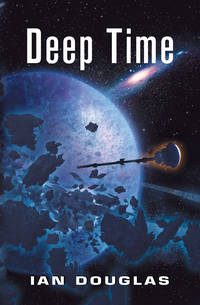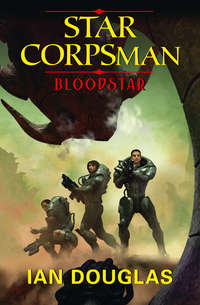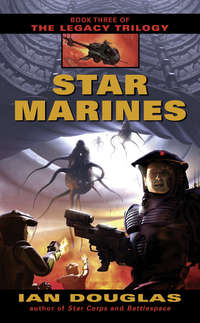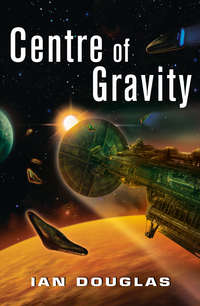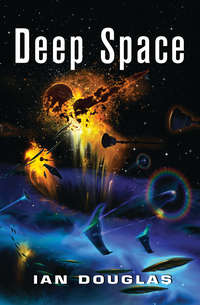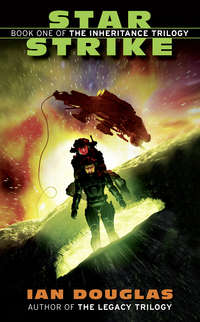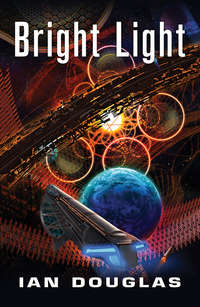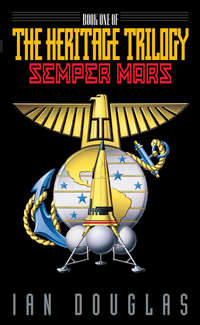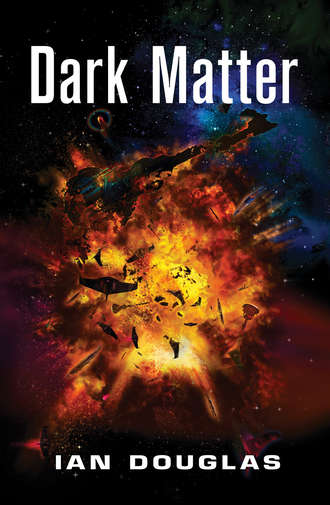
Полная версия
Dark Matter
So far, though, the Rosette Aliens hadn’t appeared to notice him. That . . . or they didn’t care.
He found the thought disturbing, akin to the thought of humans paying no attention to an ant crossing the path in front of them.
But if one of those humans chose to bring his foot down just so . . .
“I recommend dropping the sheath,” his AI told him. “We are approaching our objective.”
“Do it,” Walton said. “Let’s see what we have.”
He braced himself . . . and just in time. The sheath fell away as the artificial intelligence running the Shadowstar reconfigured the drive singularity, and the dazzling light of the heart of a globular cluster flooded in.
Millions of stars crowded one another across the spherical interior of that radiant sky. Streaks of blackness showed where the Rosette Aliens had been busy at their enigmatic work of demolition and construction. Visible, too, was the tangle of structures created over the past few months by the aliens, an incredibly vast spider’s web of pale blue light apparently anchored on and within the encircling stars.
Ahead and to starboard, a cluster of spheres hung adrift in space, each gleaming silver and as reflective as liquid mercury. And to port: the Black Rosette.
Whirling about their common center of gravity at 26,000 kilometers per second, the six black holes themselves were little more than a circular blur. Gas and dust streamed in from surrounding space, encircled the Rosette in a tight spiral radiating far into the short end of the electromagnetic spectrum and filling the sky with actinic blue-violet light. Hard radiation glared from the annihilation of infalling dust. This was, Walton thought, an extremely dangerous place to be. His ship’s shields would hold off the radiation for a time, but not indefinitely.
Walton’s Shadowstar was drifting rapidly across the face of that spiral, 100,000 kilometers away from the central maw. The expanse of space haloed by the rotating singularities revealed a starscape beyond, but not the vista of the Omega Centauri cluster.
He glimpsed a starfield . . . but one far thinner and poorer than that of the interior of the cluster. That scene was replaced in an instant by utter strangeness, by twisted and entangled streamers of red and gold and blue, the heart, possibly, of a nebula . . . or just possibly something else entirely, something beyond human experience. After that, more starfields, coming in rapid succession, and then a vast and mottled expanse of deep red-orange glare . . . the surface, he thought, of a red sun, a red dwarf, possibly, seen at close range. More starfields . . . and a panorama that seemed to show a spiral galaxy tilted sharply on end . . . and then a blast of blue light and hard radiation—a supernova, perhaps—or, again, something for which human astrophysics had no name.
Walton had the distinct impression that the scenes revealed within the Rosette changed as his angle of sight changed. There were myriad distinct paths through that gravitationally tortured gateway . . . that rip in the fabric of spacetime itself, and he was glimpsing hundreds of them as his Shadowstar fell across the Rosette’s maw. So fascinated was he by the succession of alien vistas that his AI had to give him the warning.
“We have elicited a response from the Rosette Aliens,” the Shadowstar’s artificial intelligence announced, its mental voice as calm and dispassionate as a netfeed announcement of next week’s weather over Omaha. “Directly ahead.”
Walton jerked his attention from the Black Rosette, and turned it instead to a bright silver star moving now into his recon ship’s path. He enhanced the magnification, zooming in on a perfectly reflective sphere that did not register on radar or any of his other sensors, save those recording the visible portion of the electromagnetic spectrum. He couldn’t even guess at the range or size of the thing. It might have been a meter across and a hundred meters away, or a kilometer across and much, much farther away. Since it was visible, a laser pulse would have given him a precise range . . . but a laser pulse might be interpreted as an attack.
Walton’s orders were specific: Do not provoke the aliens; do not initiate a hostile exchange.
He wished the aliens themselves had received those orders. According to the guys and gals in America’s intelligence department, they’d vaporized an unarmed survey vessel a few months ago, along with two escorting destroyers. That sounded like a pretty solid initiation of hostilities to him.
But the scale and scope of the stellarchitecture visible now around the Rosette gave some pretty convincing testimony about the aliens’ technological abilities, suggesting that nothing the human squadron could do would pose a particular threat to them.
The target ahead was growing steadily brighter. Since the thing appeared to be reflecting ambient light from the surrounding stars rather than glowing with its own, that suggested that he was closing with it.
“Engage drive,” he told the AI. “Let’s end for end and scoot.”
“That is not possible,” the AI replied.
“Why the hell not?”
“Unknown. Attempts to initiate singularity projection have failed. The Rosette Aliens may be manipulating local space in such a way as to damp out such attempts.”
“Shit! What about the power tap?”
The Shadowstar’s power plant was a scaled-down version of the power taps on board America and all other human starships. Microscopic artificial black holes rotated around one another on a subatomic scale, liberating a fraction of the zero-point energy available in hard vacuum at a quantum level. If the aliens had damped out his drive singularity, his power plant would have been affected too.
And yet, his in-head instrumentation showed a steady flow of energy.
“Ship power tap is functioning at optimum,” the AI told him.
“Can you explain that?”
“No . . . other than to suggest that the Rosette Aliens are damping out a very small and very specific volume of space immediately ahead of the ship.”
Walton had no idea how such a thing could be accomplished. An old, old phrase from the literature of some centuries before came to mind, a phrase suddenly sharply relevant. “Any sufficiently advanced technology is indistinguishable from magic.” He didn’t remember where the quote was from, and didn’t have the time now to look it up. He planned to do so once he got back to the America.
If he got back to the America. The silver sphere ahead was now rapidly growing larger, approaching him at high speed. His AI flashed a full update back to the carrier group.
And then the sphere, the encircling walls of brilliant stars, the mysterious and bizarrely twisted alien structures, the gaping maw of the Rosette, everything smeared halfway around the sky before winking into blackness. . . .
Chapter Two
20 January 2425
Recon Flight Shadow-One
Omega Centauri
1122 hours, TFT
. . . and then exploded into visibility once more.
Walton blinked. America hung in space 10 kilometers directly ahead. An instant before, he’d been almost 50 astronomical units away from the carrier . . . a distance of 7.5 billion kilometers, drifting at a velocity of a kilometer per second. Now he was traveling at the same speed, but his course had changed 180 degrees, and somehow he’d leaped across 50 AUs in an instant, and without accelerating to near c.
He remembered the way the sky had smeared around him, as though the space through which he’d been traveling had been bent through 180 degrees. And an instantaneous jump of 50 AUs? That was simply flat-out impossible. Even at close to the speed of light and subject to relativistic time dilation, he would have experienced some time making a passage that long . . . and fighters were too small by far to mount the drive projectors necessary for the faster-than-light Alcubierre Drive.
Alien magic. . . .
Working through his AI, which with a machine’s tight focus seemed unsurprised by any of this, Walton decelerated, drifting into America’s inner defense zone. “America!” he called. “America, this is Shadow One!”
There was a real danger that the carrier’s automated defense systems would target the incoming fighter and destroy it. The Shadowstar’s IFF should have flagged him as friendly on America’s scanners . . . but Walton found himself nursing a profound mistrust of the technology. Right now, the universe didn’t appear to be functioning the way it should.
And the recon fighter should not have been able to simply drop inside America’s defensive perimeter that way. It not only violated the rules and regs of combat operations . . . but it violated the laws of physics as well.
“Shadow One, America!” the voice of the ship’s CIC called. “What the hell are you doing there?”
“I . . . I’m not entirely sure, America. One second I was at the Black Rosette. The next . . .”
There was a long pause from the carrier, as though they were waiting for Walton to finish the thought. “Very well, Shadow One,” CIC replied after a moment. “You are cleared for approach and trap. C’mon in.”
“Copy. Accelerating.”
He didn’t trust himself to say more.
USNA CVS America
Omega Centauri
1205 hours, TFT
“So, we’re left knowing even less than we knew before,” Gray said. “Super-powerful aliens are dismantling a star cluster . . . and when one of our recon ships gets too close they teleport it across fifty AUs without even breaking a sweat. Recommendations?”
Gray was in America’s main briefing room with his command staff and department heads. Half were there physically; the rest had linked in from other parts of the ship. One entire bulkhead had been turned into a viewall, which was displaying video of Walton’s flyby of the Rosette. At the moment, it was showing the alien structures, looming vast and shadowy across the backdrop of stars.
“What . . . what they did to our recon fighter,” Lieutenant Commander Philip Bryant said slowly, shaking his head, “is flat-out impossible according to all of the laws of physics we understand.” He was the America’s chief stardrive engineer, and arguably the ship’s officer most conversant with her Alcubierre Drive and the essential malleability of empty space in the presence of powerful gravitational fields.
“The sheer power . . .” That was America’s other senior engineering officer, Commander Richard Halverson, the newly promoted head of the ship’s engineering department, and an expert on power taps and vacuum energy.
“Yeah. How the hell are we supposed to fight something like that?” Commander Dean Mallory was America’s chief tactical officer. “They could swat us like a bug if they wanted.”
“I don’t think the admiral was suggesting we fight,” Captain Connie Fletcher said. She was America’s CAG, an old acronym identifying a carrier’s Commander Air Group from back in the days of wet-Navy ships and aircraft. “That would be pretty pointless, right?”
“It would be more like fucking suicide,” Commander Victor Blakeslee, America’s senior navigation officer, said, scowling. “Recommendations? Hell, my recommendation is that we chart a course for home and high-tail it.”
“Assuming they let us go,” the voice of Acting Captain Gutierrez added. She was on America’s bridge, but telepresencing the planning session through her in-head. “It might not be that easy.”
“We have no reason yet to assume hostile intent on the part of the Rosette Aliens.” Lieutenant Commander Samantha Kline was the head of America’s xenobiology department—“X-Dep,” for short. “They could have vaporized Lieutenant Walton. Instead, they bent space to drop him back here.”
“I would remind you,” Halverson said slowly, “that those . . . those things out there did vaporize the Endeavor, the Herrera, and the Miller. If that’s not a hostile act, what the hell is?”
“The vid returned by the HVK robot is . . . open to interpretation, sir,” Kline replied. “That might have been an accident. Or a mistake . . .”
“A mistake by beings that powerful?” Fletcher said. “Beings that much like . . . like gods? That’s a pretty scary thought all by itself.”
“They are powerful,” Gray said. He wanted to redirect the session away from the aliens’ godlike aspect, however. He didn’t want his staff demoralized before they even encountered the Rosette Aliens directly. “But they’re not gods. If they did make a mistake when they destroyed the Endeavor, that would pretty much prove it, don’t you think?”
“More likely,” Dr. George Truitt said, “it simply means they don’t care. Keep in mind, people, that we could be dealing with a K-3 civilization here.”
Truitt was a civilian specialist assigned to America, and he was something of a wunderkind. He was a xenosophontologist, studying nonhuman minds and ways of thinking, and therefore worked in X-Dep under LCDR Kline.
Gray frowned at Truitt. In November, just two months ago, the man had been instrumental behind the scenes in devising a bit of offensive propaganda that had secured a Terran victory at Osiris—70 Ophiuchi A II—a colony world conquered by a Sh’daar client race called the Slan. By carefully analyzing communications with the Slan commander and what had been gleaned about their biology, Truitt and his xenosoph people had extrapolated a likely model of Slan psychology, one showing that they would be horrified at the idea of attacking their own community, an unthinkable act of barbarism . . . an act of animals. By beaming a message to the Slan suggesting that humans thought the same way Slan did, that humans actually shared the Slan collective-based psychology, Gray had forced the technologically superior Slan fleet to break off and retreat . . . a singular, spectacular victory.
And Truitt was the instrument of that victory.
It was too bad, Gray thought, that Truitt was also an egoistic grandstander, pompous, and possessing of social graces approximately on a par with wolverines.
“What the hell,” Mallory asked, “is a K-3 civilization?”
“Christ, you don’t know what Kardashev classification is?” Truitt said, glaring at Mallory. “I hope you understand tactics, Commander, better than you do technic sophontology.”
“Kardashev was a Russian astronomer,” Gray put in, “who developed a means of classifying planetary or interstellar civilizations based on how much energy they use. A K-3 civilization would use roughly as much energy as is emitted by all the stars of an entire galaxy.”
“That is a gross oversimplification,” Truitt said. “In point of fact—”
“If you please, Doctor,” Gray said sharply, interrupting, “we’re not here to argue definitions or sophontology. The Rosette Aliens have demonstrated the ability to rework an entire globular cluster, millions of stars—which, on the Kardashev scale, makes them at least a high K-2, and quite possibly a K-3. Human technology currently stands at . . . what is it, Doctor? K-1.2?”
“Approximately that,” Truitt said, “yes. But—”
“The point is that our industrious friends out there, as a civilization, routinely wield something like one hundred quintillion times more power than we can. I agree with Commander Blakeslee. There’s little we can do here, except establish automated monitoring stations.”
“Again, assuming they let us leave,” Captain Guiterrez said. “We are deep, deep inside their operational area.”
Gray opened a new channel within his in-head circuitry, and the bulkhead opposite the view of the cluster’s heart flowed and shimmered and then lit up with a schematic of the star cluster. The stars themselves were ghosted; otherwise, points of interest at the very center, including the position of America’s task force, would have been completely hidden.
With a thoughtclick, the view zoomed in on Omega Centauri’s heart. The entire cluster was a tightly packed ball of suns about 230 light years across, but the Black Rosette—and the majority of the alien constructs—was at the very center, and America and the other Earth ships were only 50 AUs away—no distance at all in interstellar terms. One AU was defined as the distance between Earth and her sun—150,000,000 kilometers, on average. A single light year was roughly equal to about 64,000 Astronomical Units.
It was interesting, Gray thought, not to mention quite worrying, that the aliens, whoever and whatever they were, had taken no apparent notice whatsoever of America and the ships with her. Carrier Battlegroup 40 consisted of the star carrier America; one cruiser, the Edmonton; three destroyers, the Ramirez, the John Young, and the Spruance; plus the provisioning ship Shenandoah. Though small as naval task forces went, the squadron represented a great deal of firepower, and yet the aliens had simply ignored them when they dropped out of their Alcubierre metaspace bubbles on the doorstep of . . . whatever the hell it was that they were building here.
But they’d moved Walton’s recon ship when it drifted in front of the Black Rosette. Maybe they did care about humans . . . that or else human activity actually could inconvenience them or somehow pose a threat to their operations.
Which was it? And how could the task force answer that question?
“How would X-Dep suggest we communicate with these . . . people?” Gray asked.
“We can’t,” Truitt said.
“We might try various Sh’daar languages,” Kline added. “The Agletsch trade pidgins.”
“Whoever the Rosette Aliens are,” Truitt said, “they likely come from a long way off. I doubt they’ve ever heard of the Sh’daar Collective or the Agletsch.”
The Agletsch were a galactic spacefaring species well known as traders of information. Two had been on board America until her last swing past Earth, when they’d disembarked for an extended chat with naval intelligence Earthside. The Agletsch were known to carry minute artificial intelligences within them, called Seeds, that communicated with the Sh’daar when they were within range. Having them on board a military vessel was always a risk, since the Sh’daar Seed might well compromise the ship’s security . . . but they were also incredibly useful as allies. Agletsch knowledge spanned a large fraction of the Sh’daar Collective, and their knowledge of artificial trade languages, developed to allow diverse members of the Collective to communicate with one another, had more than once proven vital.
“I’m not so sure about that,” Gray said. “We know the Rosette started off as the Six Suns, almost a billion years ago. We know that the Builders left TRGA cylinders scattered across the galaxy, and that those artifacts allow at least a limited form of time travel. The Rosette Aliens might be the Builders . . . and if so, they’ve had contact with the Collective . . . or at least with the Sh’daar of over eight hundred million years ago.”
The TRGA cylinder at Texaghu Resch had provided access to the Sh’daar inhabiting the N’gai Cloud 876 million years ago. It was generally believed, however, that the civilization that had constructed the TRGA cylinders was far older, and far more advanced, than even the now-vanished ur-Sh’daar.
“We have no evidence that these aliens are the Builders,” Truitt snapped. “The Builders in any case are probably long extinct.”
“I wonder?” Kline said. “A K-3 civilization might well be beyond threats of extinction. At the very least, they likely possess what for all practical intents and purposes amounts to both individual and cultural immortality.”
“Don’t you think that a true galaxy-wide civilization, a K-3,” Gray said, “would be aware of other K-3 level civilizations nearby? That they would be able to communicate with one another?”
“Some of the electronic Agletsch pidgins might be ideal for that,” Kline said. “They were designed for sapient species that have little or nothing in the way of biological similarities.”
“But we’ve already transmitted messages of friendship and requests for open communications channels,” Commander Pamela Wilson said. Like Gutierrez, she was on the bridge at the moment, but linked in to the briefing session electronically. “In Drukrhu, and in four other Agletsch pidgins.”
The languages had been loaded into America’s AI, so the Agletsch themselves weren’t necessary for translations. Gray wished the spidery little aliens were still on board, however. He would have liked to ask them if they’d ever encountered anything like the Rosette Aliens.
But then again, the Agletsch traded in information, and rarely gave away anything for free. That particular bit of data might well be priced beyond Gray’s reach.
He would have some questions for them, though, once America made it back to Earth.
“Very well,” he said. He focused his concentration for a moment, composing a new message. “Transmit this, Commander Wilson, broadband and in all known Sh’daar languages.
“Commander Blakeslee? Give us a course out of the cluster. We’re going to head for home.”
Emergency Presidential Command Post
Toronto
United States of North America
1435 hours, EST
“What the hell is going on over there, Marcus?”
Marcus Whitney, the president’s chief of staff, spread his hands. “Damned if I know, Mr. President. Intelligence doesn’t have a clear picture right now.”
“Do we now what’s happened to President Roettgen?”
“No, sir. Presumably, she was in the Ad Astra Complex when the rebel forces overran the place. She may be a prisoner; she may be dead.”
Alexander Koenig, president of the United States of North America, stared at the viewall news feed and wondered if this would be the end of the war. Facts were sketchy, less than trustworthy, and often contradictory.
But it did appear that the Terran Confederation government was on the point of collapse.
The United States of North America had been a part of the Terran Confederation since 2133 and the creation of the Pax Confeoderata. That union had become increasingly strained, however, until open warfare had broken out.
The causes of war were varied, but chief among them was a fundamental disagreement over how to prosecute the Sh’daar War. The USNA was committed to continuing the fight. The Confederation government wanted to accept the Sh’daar Ultimatum and become a part of the Sh’daar Collective. Disagreement in extrasolar policy—together with lesser issues such as rights of self-determination and rights to abandoned coastal areas like Manhattan, Baltimore, and Washington, D.C.—had led first to skirmishes in space, then to all-out war. Geneva’s forces had attacked the flooded ruins of D.C. and attempted to capture the Tsiolkovsky Array, the hyperintelligent AI computer complex on the lunar far side. Both attempts had been beaten off . . . but then the unthinkable had taken place.
On 15 November, 2424, Confederation ships had struck the USNA capital at Columbus from space with a nano-deconstructor warhead, chewing a hole three kilometers wide and half a kilometer deep down into the heart of the city in an attempt to decapitate the North American leadership—meaning Koenig himself, as well as the USNA’s Earth-based command and control assets.
The attack had failed—though the city had been destroyed and millions of people killed. The heavily shielded presidential command bunker had been two kilometers down . . . and Koenig and his staff had been able to escape by high-speed maglev train through a deep, evacuated rail tunnel connecting to the city of Toronto. And from the emergency command center set up in and beneath Toronto’s York Civic Complex, the USNA government had continued the war.
Now, two months later, it appeared that the Confederation effort was collapsing.
Appeared. That was the operative word. It won’t do, Koenig thought, to become overconfident now, or to drop your guard. The devastating nano-D attack on Columbus, an atrocity in contravention of any number of treaties and protocols, had triggered defections from the Confederation ranks. Russia and North India both had seceded from the Confederation and allied with the USNA. Two powerful independent powers had entered the war as well—the Chinese Hegemony and the Islamic Theocracy, both long excluded from the Confederation, both siding with the USNA in exchange for promises of inclusion in any new Earth government.


